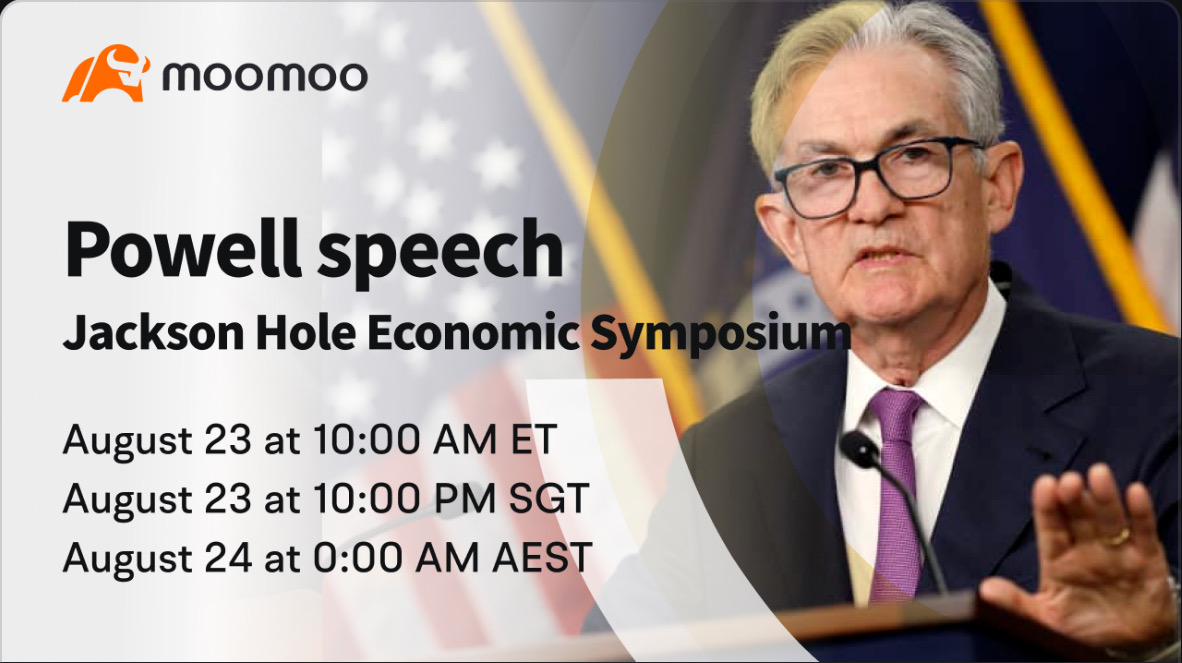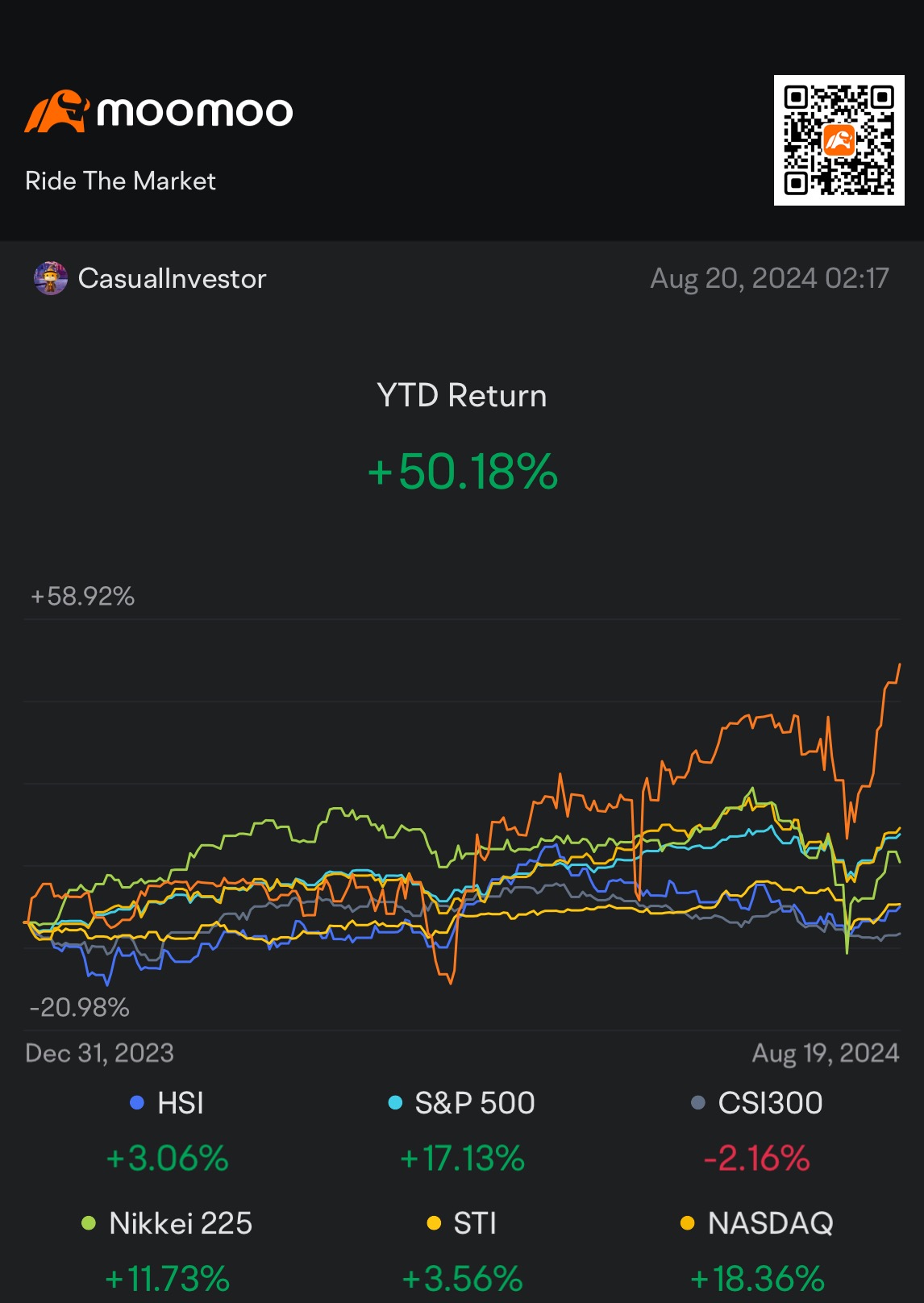Economic Crossroads: Will the Fed Slash Rates as Inflation Shows Signs of Easing
Hi Mooers, Are you booked for the event. ![]()

Everyone can guess and say whatever they feel, if the Feds will cut or continue with looking for more data. Some say Feds are behind the curve, a little too late.
Instead of guess work. What are the factors that will contribute to this decesion? Let’s have a look with some help from our friendly neighbourhood 🤖. ![]()
Several key economic indicators play a crucial role in determining whether the Federal Reserve will raise, lower, or maintain interest rates during this Jackson Hole Economic Symposium event. These indicators help the Fed assess the state of the economy, particularly inflationary pressures and economic growth. The most significant ones are:
1. Core CPI (Consumer Price Index): Core CPI excludes volatile food and energy prices, providing a clearer view of underlying inflation trends. A higher-than-expected Core CPI indicates stronger inflation, which could lead to interest rate hikes to curb inflation. Conversely, lower-than-expected Core CPI suggests weaker inflationary pressure, potentially leading to a pause or reduction in interest rates.
2. PCE (Personal Consumption Expenditures) Price Index: The Fed’s preferred inflation gauge, the PCE index, particularly the Core PCE (which also excludes food and energy), is closely monitored. Persistent increases in the PCE index could prompt the Fed to raise rates, whereas a cooling in this index might lead to a rate cut or pause.
3. Unemployment Rate and Labor Market Data: The Fed also pays close attention to employment figures. A low unemployment rate with strong job growth can indicate an overheating economy, leading the Fed to raise rates to prevent inflation. Conversely, rising unemployment or weaker job growth might prompt rate cuts to stimulate economic activity.
4. GDP Growth: The growth rate of the economy, as measured by GDP, is another crucial factor. Strong GDP growth might justify higher rates to prevent the economy from overheating, while weak or negative growth might lead the Fed to lower rates to encourage spending and investment.
5. Wage Growth: Rapid wage growth can be a sign of rising inflationary pressures, particularly if it’s not matched by productivity gains. This might lead the Fed to raise rates. Slower wage growth might suggest less inflationary pressure, potentially leading to lower rates.
6. Retail Sales and Consumer Spending: These indicators provide insight into the health of consumer demand. Strong consumer spending might lead the Fed to consider raising rates, while weak spending could suggest the need for rate cuts.
7. Producer Price Index (PPI): This measures inflation from the perspective of producers and can be a leading indicator of consumer inflation. A rising PPI might prompt the Fed to raise rates, while a declining PPI could lead to lower rates.
8. Inflation Expectations: Surveys of inflation expectations, such as those from the University of Michigan, provide insight into how consumers and businesses expect prices to move. If inflation expectations rise significantly, the Fed might raise rates to prevent a self-fulfilling prophecy of higher inflation.
1. Core CPI (Consumer Price Index): Core CPI excludes volatile food and energy prices, providing a clearer view of underlying inflation trends. A higher-than-expected Core CPI indicates stronger inflation, which could lead to interest rate hikes to curb inflation. Conversely, lower-than-expected Core CPI suggests weaker inflationary pressure, potentially leading to a pause or reduction in interest rates.
2. PCE (Personal Consumption Expenditures) Price Index: The Fed’s preferred inflation gauge, the PCE index, particularly the Core PCE (which also excludes food and energy), is closely monitored. Persistent increases in the PCE index could prompt the Fed to raise rates, whereas a cooling in this index might lead to a rate cut or pause.
3. Unemployment Rate and Labor Market Data: The Fed also pays close attention to employment figures. A low unemployment rate with strong job growth can indicate an overheating economy, leading the Fed to raise rates to prevent inflation. Conversely, rising unemployment or weaker job growth might prompt rate cuts to stimulate economic activity.
4. GDP Growth: The growth rate of the economy, as measured by GDP, is another crucial factor. Strong GDP growth might justify higher rates to prevent the economy from overheating, while weak or negative growth might lead the Fed to lower rates to encourage spending and investment.
5. Wage Growth: Rapid wage growth can be a sign of rising inflationary pressures, particularly if it’s not matched by productivity gains. This might lead the Fed to raise rates. Slower wage growth might suggest less inflationary pressure, potentially leading to lower rates.
6. Retail Sales and Consumer Spending: These indicators provide insight into the health of consumer demand. Strong consumer spending might lead the Fed to consider raising rates, while weak spending could suggest the need for rate cuts.
7. Producer Price Index (PPI): This measures inflation from the perspective of producers and can be a leading indicator of consumer inflation. A rising PPI might prompt the Fed to raise rates, while a declining PPI could lead to lower rates.
8. Inflation Expectations: Surveys of inflation expectations, such as those from the University of Michigan, provide insight into how consumers and businesses expect prices to move. If inflation expectations rise significantly, the Fed might raise rates to prevent a self-fulfilling prophecy of higher inflation.
The Fed’s decisions are typically based on a combination of these indicators rather than any single one.
So how will recent data and effects this September decisons? ![]()
1. Core CPI (August 2024): Increased by 4.3% year-over-year, showing a continued but gradual decline in inflation pressures.
2. Core PCE Index (June 2024): Up by 2.6% year-over-year, remaining above the Fed’s target.
3. Unemployment Rate (July 2024): Steady at 3.6%, indicating a tight labor market.
4. GDP Growth (Q2 2024): 2.4% annualized growth, suggesting moderate economic expansion.
5. Wage Growth (July 2024): 4.4% year-over-year increase, continuing to pressure inflation.
6. Retail Sales (July 2024): Rose 0.5% month-over-month, reflecting steady consumer demand.
7. Producer Price Index (July 2024): Core PPI rose by 0.3%, indicating continued inflation at the producer level.
These indicators suggest a complex economic landscape that the Fed must navigate as it considers future interest rate changes.
2. Core PCE Index (June 2024): Up by 2.6% year-over-year, remaining above the Fed’s target.
3. Unemployment Rate (July 2024): Steady at 3.6%, indicating a tight labor market.
4. GDP Growth (Q2 2024): 2.4% annualized growth, suggesting moderate economic expansion.
5. Wage Growth (July 2024): 4.4% year-over-year increase, continuing to pressure inflation.
6. Retail Sales (July 2024): Rose 0.5% month-over-month, reflecting steady consumer demand.
7. Producer Price Index (July 2024): Core PPI rose by 0.3%, indicating continued inflation at the producer level.
These indicators suggest a complex economic landscape that the Fed must navigate as it considers future interest rate changes.
So Bull or Bear? Rocket or Meh? Depends if your going long or short term.
Given the current economic indicators, especially for me as an investor, a cautious approach is advisable in the short term, leaning slightly bearish. Here’s are the factors why:
1. Inflationary Pressures: While inflation is easing, the Core CPI remains elevated at 4.3%, which could prompt the Fed to maintain or even raise interest rates, making borrowing more expensive and potentially dampening economic growth.
2. Interest Rate Uncertainty: The Fed's decision-making will heavily depend on upcoming data, particularly around inflation and labor market dynamics. If the Fed remains hawkish, it could weigh on equity markets, especially in sectors sensitive to interest rates.
3. Labor Market and Wage Growth: The tight labor market and strong wage growth (4.4%) could keep inflation pressures alive, leading to continued caution from the Fed, which could pressure corporate profit margins and, by extension, stock prices.
4. Economic Growth: The moderate GDP growth rate of 2.4% suggests the economy is expanding, but not at a pace that would support aggressive bullish positions, especially in a high-interest-rate environment.
5. Consumer Demand: Retail sales are growing steadily, but not at a pace that suggests a strong economic acceleration. This could lead to mixed performances across consumer-driven sectors.
Conclusion:
While there are some positive signals like steady consumer demand and moderate GDP growth, the persistent inflation, coupled with the uncertainty surrounding the Fed's interest rate policy, makes a bearish or neutral stance more prudent in the short term. Investors might consider reducing exposure to interest rate-sensitive sectors and focusing on quality stocks with strong balance sheets that can weather potential market volatility.
1. Inflationary Pressures: While inflation is easing, the Core CPI remains elevated at 4.3%, which could prompt the Fed to maintain or even raise interest rates, making borrowing more expensive and potentially dampening economic growth.
2. Interest Rate Uncertainty: The Fed's decision-making will heavily depend on upcoming data, particularly around inflation and labor market dynamics. If the Fed remains hawkish, it could weigh on equity markets, especially in sectors sensitive to interest rates.
3. Labor Market and Wage Growth: The tight labor market and strong wage growth (4.4%) could keep inflation pressures alive, leading to continued caution from the Fed, which could pressure corporate profit margins and, by extension, stock prices.
4. Economic Growth: The moderate GDP growth rate of 2.4% suggests the economy is expanding, but not at a pace that would support aggressive bullish positions, especially in a high-interest-rate environment.
5. Consumer Demand: Retail sales are growing steadily, but not at a pace that suggests a strong economic acceleration. This could lead to mixed performances across consumer-driven sectors.
Conclusion:
While there are some positive signals like steady consumer demand and moderate GDP growth, the persistent inflation, coupled with the uncertainty surrounding the Fed's interest rate policy, makes a bearish or neutral stance more prudent in the short term. Investors might consider reducing exposure to interest rate-sensitive sectors and focusing on quality stocks with strong balance sheets that can weather potential market volatility.
Important Disclaimer: Investment involves risks and the potential to lose principal. It is not suitable for everyone, and users will have to make their own individual investments decisions.
For those wanting to jump in and gain from the volatility, my personal take and experience ah…
Bearish: 🐻 You can either sell your stocks now for a better entry, buy PUT options or covered calls to protect your assets.
Bullish: 🐮You can either buy stocks or ETFs, buy CALL options or sell PUTS (High risk).
(For options. My preference, don’t go with too short days to expiry as the time decay is large and not enough time to react if the option swing against you. Unless your layering with many positions. Not put all your eggs in 1 basket 🧺 .)
If the Federal Reserve does not reduce interest rates this September 2024, the next opportunity for a potential rate change would typically be at the following Federal Open Market Committee (FOMC) meeting in November 2024. During this meeting, the Fed will reassess economic conditions and decide on the appropriate course of action regarding interest rates.

As a casual investor ![]() , I try to keep myself updated with global and economic factors before making long term strategies.
, I try to keep myself updated with global and economic factors before making long term strategies. ![]()
As I walk the talk. ![]() If you have followed my EOY preditions for 2024. I’ve taken a Bullish stance, Strong beliver in Brother Huang $NVIDIA (NVDA.US)$ and have my strategies for the long term tailored as such. From Cherry picking stocks to options trading $Apple (AAPL.US)$ & $Tesla (TSLA.US)$ .
If you have followed my EOY preditions for 2024. I’ve taken a Bullish stance, Strong beliver in Brother Huang $NVIDIA (NVDA.US)$ and have my strategies for the long term tailored as such. From Cherry picking stocks to options trading $Apple (AAPL.US)$ & $Tesla (TSLA.US)$ .

YTD 50% ![]()
![]()
![]() Is it a Sign that rates Cuts is 50/50?
Is it a Sign that rates Cuts is 50/50? ![]()

LEAP position to close in Dec 2024. Premium was reinvested to take more positions and gain short term price movements.


You can follow my new channel thats developing for more of my content. ![]()
Well back to working on my episode 2. Thank you all for your support New channel Need your clicks ⏩Casual Investor Talks🔗
Disclaimer: Community is offered by Moomoo Technologies Inc. and is for educational purposes only.
Read more
Comment
Sign in to post a comment

